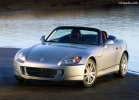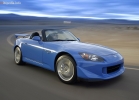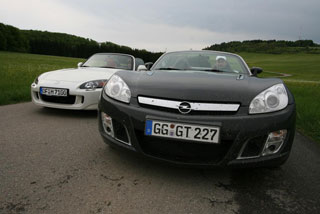Honda S2000 test drive since 1999 Cabriolet
S2000
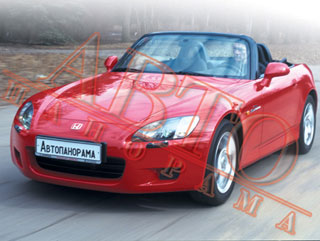 The Japanese have more than once forced European automakers to start. You don’t have to go far for examples: a loud commotion in the camp of sports cars was caused by a 2-seater class of Honda S2000, which appeared in Europe in the fall of last year.
The Japanese have more than once forced European automakers to start. You don’t have to go far for examples: a loud commotion in the camp of sports cars was caused by a 2-seater class of Honda S2000, which appeared in Europe in the fall of last year. The S2000 model, which converges from the conveyor in the tochigi, is a vivid embodiment of the modern Japanese concept of sports cars, in which the latest technologies are combined with the classical layout, and the impressive figures of technical characteristics can make complete confusion into the ranks of competitors. However, in order to release the best sports car in the world and accept enthusiastic applause, it is not enough just to take a well -proven recipe and use selected seasonings! A visual example can be found in the lineup of the same Honda compartment NSX, characterized by exceptionally high dynamics and a complete commercial failure.
For real success, a sports, but not a racing car, you need to light up the owner of emotions and a smile of delight on the face of everyone who at least a little while driving. Honda S2000 is just distinguished by a rather powerful emotional fuse. Its 2-liter engine develops 240 hp. At 8300 rpm, without the help of superchargers! Add to this a 6-speed box with converged gears, the weight of the VW Golf car level and get a very spicy dish.
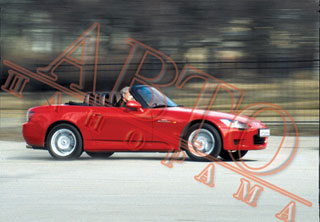 But it is not enough to prepare a dish, it must be skillfully served. And here there is no doubt that Honda designers worked on fame. The cone -shaped, reminiscent of the head of the shark, the front provides the car expressive and recognizable outlines. The outlines of the S2000 are beautiful and at the same time appropriate, and many elegant details are able to please even high aesthetic taste.
But it is not enough to prepare a dish, it must be skillfully served. And here there is no doubt that Honda designers worked on fame. The cone -shaped, reminiscent of the head of the shark, the front provides the car expressive and recognizable outlines. The outlines of the S2000 are beautiful and at the same time appropriate, and many elegant details are able to please even high aesthetic taste. But the real quintessence of the dish is a 4-cylinder motor, equipped with a well-known system for changing the VTEC gas distribution phase. Working on it, Honda engineers truly surpassed themselves by creating a 16-valve high-speed engine with specific power, which will envy any serial engine without a boost. Designers do not hide the fact that when creating the S2000 engine, they used all the experience that was accumulated in the development of Formula 1 engines. Engine with a working volume of 1997 cubic meters. SM from each liter of working volume removes 120 hp, and the red zone begins at 9000 rpm. At the same time, S2000 has a rather modest torque of only 208 Nm. This figure is not surprising for most modern sedans with 2-liter engines. It is even more discouraged that such a modest craving manifests itself only when the engine is promoted to about 7500 rpm. This causes associations rather with motorcycle engines.
In general, the S2000 motor leaves approximately the same impressions as other motors with the VTEC system, but the engine of the new relatives brings emotions to the boiling point, especially contrasting its restless character. In the upper speed range (about 2500 rpm to the red zone), the motor carries the car with the same ease with which the wind blows fallen leaves from the asphalt. However, at a speed of less than 5000, the illusion arises that the engine, and with it, the car falls into a deep lethargic sleep, and even doubt begins to creep on the veracity of the declared dynamic characteristics.
 The essence here is the VTEC system, the technical sophistication of which is actually not the most sophisticated way to control the phases of gas distribution. As soon as the motor is spent to the magic 5850 rpm, the rockers switch to fists that open the valves earlier and provide a large height of the valve lifting, which leads to the awakening of the true force of the 2-liter Honda motor. The tachometer arrow skips marks 7,000 and 8000 revolutions, until about 9,000 an indicator that calls for the next gear somewhere around 9,000. A short, literally shock shift in the transmission, turns falls almost to the same magical value of 5850 rpm, and the picture is repeated almost at the previous speed. Praise Honda engineers who have taken care of the exact selection of gear rates and created an exclusively quick gearbox mechanism. After such active exercises with a short -flowing titanium gearbox control lever, you again gain faith in the ability of the car to show 100 km/h through 6.2 s and issue a maximum speed of 240 km/h.
The essence here is the VTEC system, the technical sophistication of which is actually not the most sophisticated way to control the phases of gas distribution. As soon as the motor is spent to the magic 5850 rpm, the rockers switch to fists that open the valves earlier and provide a large height of the valve lifting, which leads to the awakening of the true force of the 2-liter Honda motor. The tachometer arrow skips marks 7,000 and 8000 revolutions, until about 9,000 an indicator that calls for the next gear somewhere around 9,000. A short, literally shock shift in the transmission, turns falls almost to the same magical value of 5850 rpm, and the picture is repeated almost at the previous speed. Praise Honda engineers who have taken care of the exact selection of gear rates and created an exclusively quick gearbox mechanism. After such active exercises with a short -flowing titanium gearbox control lever, you again gain faith in the ability of the car to show 100 km/h through 6.2 s and issue a maximum speed of 240 km/h. At the same time, the voice of the motor is incomparable and seems to penetrate to the bone brain, reminding something of the noise of cars of passenger cars on ring races. Fortunately, a small section of public road was found, where it was possible to safely ride throughout the piece of iron. Under ordinary conditions of the suburban highway, a very acute characteristic of the torque with a maximum at unusually high revolutions makes the gearbox with a lever, not allowing to fall into cruise relaxation.
 With braking, on the contrary, no problems. Powerful disc brakes on all wheels easily stop the car, and the pedal is so clear that it is not difficult to slow down the car on the verge of ABS.
With braking, on the contrary, no problems. Powerful disc brakes on all wheels easily stop the car, and the pedal is so clear that it is not difficult to slow down the car on the verge of ABS. In turn, the S2000 shows extremely cold -blooded determination. The impression is that Honda designers specially deprived the control of a car of any bright features. Nevertheless, it must be admitted that the chassis of the Japanese relatives is perfectly trained for a car with rear drive wheels, his behavior does not fake any tricks, and it does without the help of electronics. A considerable merit here belongs to a very rigid carrying steel body, an independent two -winged suspension of all wheels and perfect weighting along the axes. It is quite accurately selected and a reserve of clutch with the road, so even on a not -even coating the car demonstrates insufficient rotation, and a sharp supply of fuel in low gear does not lead to an instant breakdown of the rear axle. The car gradually proceeds to neutral rotation, and only with special persistence from the driver's side the rear wheels slowly begin. It is not difficult to compensate for the skid: the steering with an electric amplifier is quite sharp and has only 2.4 turns from the stop to the stop, and the radius of the car is 10.8 m.
The suspension is close to impeccable. Attempts by the car to roll in corners instantly and mercilessly suppressed while maintaining sufficient comfort. The irregularities of the roadway are felt, but without sharp blows. However, oddly enough, with an excellent motor and an obedient chassis, such a highly appreciated response of a sports car, which the driver usually feels with his back, for some reason the creators of Honda S2000 remained behind the scenes.
The designers made sure that in the Spartan salon there was an element that immediately indicates the Hi-Tech of the mechanical part of the car of its motor. This, of course, is a dashboard with stripes of graphic indicators of fuel level, coolant temperature and a tachometer LED arc. The salon itself leaves a double impression. On the one hand, there are no except in it, except for the distance volume control of the speakers located to the right of the steering wheel, and the very emotional detail of the starter button, as in purebred racing cars. On the other hand, the salon is deprived of the special atmosphere, which you always willy-nilly expect from a sports relatives. Seats with solid leather upholstery provide a convenient landing and sufficient support, but the very layout of the driver's place with a motionless monolith of the steering column leaves an enduring sensation of a high landing. And this despite the fact that the seats pillows are almost at the level of asphalt, and the rim of the steering wheel lies almost on the knees of the driver. Probably, it is such a landing that is more familiar in the sedan than in a sports relative, and fuels rumors that Honda is preparing a classic layout sedan on the S2000 platform, capable of competing on equal terms with the BMW of the 3rd series. This still not materialized sedan will have to take the place of the current front -wheel drive model of Accord.
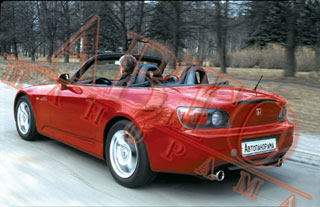 In a car claiming to demonstrate its capabilities on the racing track, an electric servo drive of a soft top seems excessive luxury, like any detail that brings additional weight. But, according to Honda, a servo drive that added only 6 kg to a car puts a hood on it in less than 10 s. In terms of convenience, the winning is indisputable. If we talk about driving with a lowered roof, then, unfortunately, the Honda S2000 cannot be attributed to those few open cars, which at a hundred speeds provide good protection of the salon from the wind.
In a car claiming to demonstrate its capabilities on the racing track, an electric servo drive of a soft top seems excessive luxury, like any detail that brings additional weight. But, according to Honda, a servo drive that added only 6 kg to a car puts a hood on it in less than 10 s. In terms of convenience, the winning is indisputable. If we talk about driving with a lowered roof, then, unfortunately, the Honda S2000 cannot be attributed to those few open cars, which at a hundred speeds provide good protection of the salon from the wind. As always, at the end of the test, you wonder which of the already famous cars can be opposed to a beginner? With regard to Honda S2000, the answer to this question is not easy to find. If we consider the Japanese relatives as an alternative to Porsche Boxster, then against the backdrop of a sports-studied German, S2000 inevitably loses due to the need for crazy work by a gear lever, an explosive nature of the motor and tiny trunk volume. If we consider this class as a response of Honda on the appearance of Lotus Elise, built strictly according to the covenants of Colin Chapman, the difference in weight is almost half a ton and the boring steering wheel incline the scales, again not in favor of the Japanese. It is most correct to provide the S2000 to be yourself, not like any other car. This is the rare type of car that needs to be controlled!
Some technical characteristics Honda S2000
(manufacturer data)
Dimensions, mm 4135x1750x1285
Equipped mass, kg 1260
Base, mm 2400
Clearance, mm 129
Trunk volume, l 152
Front/back, mm 1470/1510
Turn diameter, m 10.8
Type of engine gasoline
4-cylinder 16-valve
Working volume, cubic meter. SM 1997
Compression degree 11: 1
Max. Power, L.S./rpm 240/8300
Max. moment, nm/rpm 208/7500
Rear -wheel drive
Mechanical transmission 6-speed
Suspension in front/behind independent spring
2-crap with stabilizers
transverse stability
Front brakes/back circular ventilated 300 mm/
disc 282 mm
Steering rheckie with electric
amplifier
Front tires/back 205/55 R16/225/50 R16
Max. Speed, km/h 240
Acceleration time 0-100 km, with 6.2
Tank volume, l 50
Fuel consumption, l 13.2/7.9/9.9
Sergey Falaleev
Photo by Evgeny Amanov
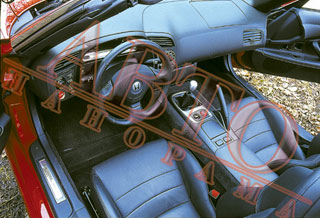





Source: Avtopanorama magazine
Honda S2000 crash tests since 1999
Honda S2000 test drives since 1999
Honda S2000 crash test since 1999
Krassh Test: Detailed Information27%
Driver and passengers
6%
Pedestrians



